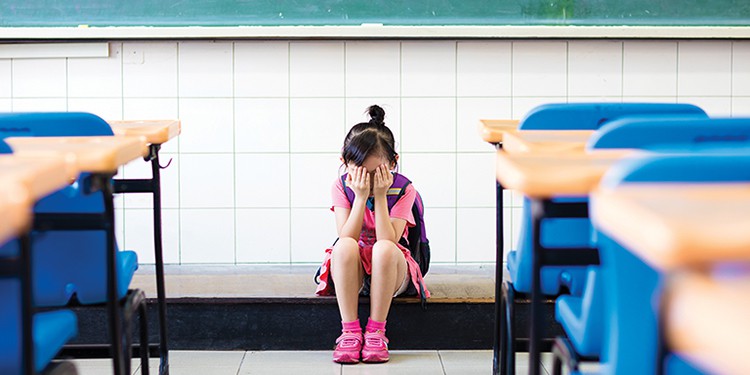
Lockdown drills have become the norm in our nation’s schools. But how can we protect kids from a potential active shooter event without traumatizing them in the process?
In a better world, learning to read and write, count and color, and get along with others would be plenty to fill the days of new kindergarteners. But Chrysalis Amour Levy dreaded another lesson her daughter would learn when she started kindergarten last fall: How to silently hide in a dark classroom, practicing what to do if a dangerous person entered her school.
Lockdowns are now a universal part of education in the United States, practiced by at least 95 percent of schools nationwide. In Oregon, they’re mandated by a 2013 law requiring all public and private K-12 schools to conduct two lockdown drills per year, legislation written in the wake of the shooting that killed 20 first graders and six educators at Sandy Hook Elementary School in Newtown, Connecticut. It’s no wonder that parents like Levy dread the thought of their children participating in lockdown drills — they’re acting out our worst nightmares.
But what if the drills are also causing nightmares? That’s what happened to Levy’s daughter, a friendly, outgoing girl who loves magic and fairies. After her first lockdown drill at Buckman Elementary, “she immediately started having nightmares, waking up in the middle of the night and wanting to sleep with us, constantly asking if the doors are locked,” said Levy. “It definitely took away her innocence.”
School shootings are rare, and statistically, schools are among the safest places for kids. Yet the inherent horror and round-the-clock media coverage keep these tragedies front of mind, and a majority of parents worry about a shooting happening at their child’s school. How are schools in Portland, especially elementary schools, balancing the mandate of practicing lockdown drills with ensuring that students feel safe and supported at school?
Portland-area schools are conducting standard lockdown drills; not active shooter exercises.
Oregon law requires schools to have lockdown drills, but it’s up to districts how to conduct them. In Oregon and around the country, some schools have turned to scarily realistic drills, involving firing blank shots to simulate gunfire, masked intruders with plastic pellet guns, and students wounded with fake blood.
These types of realistic drills can be useful training exercises for emergency responders, but they can be very traumatizing for staff and students, who shouldn’t be required to participate, said Cathy Paine, a member of the National Crisis Response Team with the National Association of School Psychologists and a retired administrator from Springfield, Oregon.
Administrators from Portland Public Schools (PPS), Evergreen, Vancouver, Tigard-Tualatin, Parkrose, and Lake Oswego school districts all said that they aren’t conducting realistic active shooter drills with students.
“I don’t know of any schools doing it that way,” John Parke, safety and security administrator for Lake Oswego School District, wrote in an email.
Instead, Portland schools reported practicing a standard lockdown drill. In PPS, these happen in every school in September and March, said Mollie Emmons, interim director of security services in the district. A “locks, lights, out-of-sight,” message plays over the intercom. Students and teachers get into their classrooms, lock the doors, turn out the lights, pull the blinds, and get out-of-sight of any windows.
“Then we sit really, really quietly together,” said Suzanne Cohen, president of the Portland Association of Teachers, who has mostly taught at the middle school level. “All the emotional reactions that you could expect in preteens happen. Some are very, very scared, some laugh nervously, some cry.”
Last year, PPS started to train staff in “options-based decision-making,” encouraging them to consider other responses to an active shooter situation beyond the standard lockdown. Some teachers, especially at the middle and high school levels, might barricade classroom doors with desks during drills, and the district is encouraging them to think through and talk with students about how they could evacuate the building if that’s their safest option, Emmons said.
Most experts agree that lockdowns save lives.
The rationale for lockdowns is that if everyone can get behind a locked door, quiet and out-of-sight, it’s harder for a shooter to find victims, buying time until emergency responders arrive. From analyzing school shootings from the last 20 years, we know that lockdowns save lives, and students should know how to do them, Paine said.
“Even for a 5- or 6-year-old who hears about [school shootings], it’s better for them to have some level of knowledge at their developmental level than to know nothing, and then be afraid. Because they will think, ‘Well, what if this happens at my school?’ and if they have no clue what to do, then that creates more anxiety.” Paine’s expertise comes in part from unenviable experience; she was a school psychologist at Springfield’s Thurston High School in 1998, when a student opened fire, killing two and wounding 25.
Cohen wishes the drills weren’t necessary, and her organization is advocating for gun laws aiming to prevent more shootings. “But as long as there’s this fear, educators want to do everything they can to protect their students,” she said. “Anything that we might’ve said to ourselves five years ago or seven years ago about the unlikeliness of ever needing this skill — I think that’s harder and harder to believe.”
There’s little research on how lockdowns affect children’s mental health.
Frustratingly, only one tiny study has addressed this question, but it’s more than a decade old and included only 74 children (ages 8 to 11 years old) who participated in a single seven-minute lockdown drill. The students in the study didn’t report more anxiety or feelings of being unsafe after the drill, but much more research is needed. And while some local parents say their children seem unaffected by lockdowns, others worry that they’re stressing their kids.
Last spring, Chris Wheeler realized that her daughter, then a third grader at Grout Elementary, was avoiding drinking water during the school day. “She didn’t want to get caught in the bathroom and have to be alone in a stall standing on a toilet with somebody dangerous in the building,” Wheeler said. After an actual lockout at her school in May (during which exterior doors were locked because of police activity in the neighborhood), her daughter cried for several hours at bedtime and didn’t want to sleep alone. Seven months later, Wheeler said her daughter has continued to have nightmares about scary things happening at school, despite being an otherwise strong and independent child, and she worries about how the drills might be affecting kids with a history of trauma or less support at home.
Summer Bennett noticed that her son became much more fearful after he started kindergarten at Scott Elementary last fall. “He started focusing on locking the doors and being safe inside the house, which he’s never talked about,” she said. Bennett is concerned that schools might be underestimating the effects of the drills, because they don’t see these subtler signs of anxiety. “It’s what happens when they get home, and they’re tired, and it’s bedtime, and they can let their guard down a little bit,” she said. “When they close their eyes, and they go to sleep at night, how it affects their dreams.”
PPS administrators acknowledged that they’re hearing from parents with similar concerns about lockdowns, especially at the elementary level. “I think we really are walking a difficult line as a district in trying to ensure that our schools, our administrators, our educators and our students are prepared for a situation like that while trying to maintain a trauma-sensitive lens, not creating more anxiety for students,” said James Loveland, senior director of Student Success and Health at PPS.
Best practices for mitigating the psychological effects of lockdowns can help guide schools.
Experts in child psychology and traumatic stress have developed guidelines for how to minimize the psychological effects of lockdown and active shooter drills in schools (For more, see our sidebar, Lockdown Drills: How to Support Your Child on page 15). “It’s very possible to do it without traumatizing kids,” Paine said. And the more engaged parents are with this process, the better. “If more parents were more vocally advocating for their students, then it would just cause the schools to be more thoughtful about it,” she said.
Good communication around drills is key. “100 percent of the time, drills need to be announced ahead of time, and yes, parents should know that they’re going to happen,” Paine said. If students and staff believe they’re in real danger, that creates more fear and potential trauma. And the National Child Traumatic Stress Network brings up the point that students and teachers can become desensitized to unannounced drills and under-respond in a true crisis situation when quick action is paramount.
Metro districts are evolving in their policies about communicating drills. At PPS, the district encourages schools to have at least one surprise drill each year (usually in the spring), and their policy is to not inform students and staff whether a lockdown is a drill or a real threat, Emmons said. North Clackamas School District also used to conduct surprise drills, but as of January 2020, they’re mandating that students and staff be notified when it is a drill, at least in part to address concerns about drills causing trauma to students, said David Kruse, risk manager for the district.
For children with a history of trauma, parents and school staff can work together to ensure they have good coping techniques or other supports during drills, or they might opt out and learn about emergency response in another way. Special consideration is also needed for children with disabilities or sensory differences. Mental health professionals should be involved in every stage of a drill, including planning, writing developmentally appropriate lessons for students, and being present during the drill and afterwards, to debrief with students and staff if needed.
Letting parents know in advance about drills allows them to be prepared to talk with their kids and watch for signs of distress. In PPS, Emmons said that most elementary principals send a note home to parents before a drill happens or just after, but this is not required by the district.
And among the parents interviewed for this article, a lack of communication was a common complaint. Both Bennett and Wheeler, parents of elementary students in the district, said they weren’t informed about drills occurring last year, and that made it more difficult to respond to their children’s behavior changes. Andrea Tomlin, mother of two children at Ainsworth Elementary, said that in her three years as a parent at the school, she’s never been informed about when drills occurred or how they were explained to her children, despite requesting this information. “They’ve completely taken us out of the conversation about our kids’ safety,” she said. Tomlin sent PPS superintendent Guadalupe Guerrero a letter last fall detailing her concerns, but she said she hasn’t received a reply. Emmons said that PPS is working to develop more trauma-informed resources so that they can better support students through drills and real incidents, and she encourages parents to reach out to school principals with questions or concerns. “We are constantly looking at our emergency planning and practice and may shift the way we conduct lockdown drills in the future so that we can build the muscle memory needed for emergency response while at the same time removing harmful impacts of emergency drills,” she said.
Lockdown Drills: How to Support Your Child
1. Be informed. Ask for the drill schedule and information about how drills are conducted at your child’s school so that you’re prepared for conversations with her before and after drills.
2. Talk with the school’s principal or counselor if you’re concerned the drill might cause a traumatic reaction in your child.
3. After a drill, talk with your child. Listen and validate her feelings; offer reassurance that schools are safe and violent incidents are very rare.
4. Use language your child can understand. Emphasize that the purpose of the drill is to keep your child safe. If “stranger danger” is familiar to your child, this concept may be helpful.
5. Contact the school’s counselor if you’re concerned about how your child has responded to a drill or lockdown.
Learn more
These organizations offer best practices for minimizing trauma from drills:
National Association of School Psychologists: nasponline.org.
The National Child Traumatic Stress Network: nctsn.org.
- The Science of Sleep - April 29, 2020
- The Mental Impact of School Lockdown Drills - February 10, 2020
- Is Cannabis Safe During Pregnancy & Breastfeeding? - May 10, 2019





